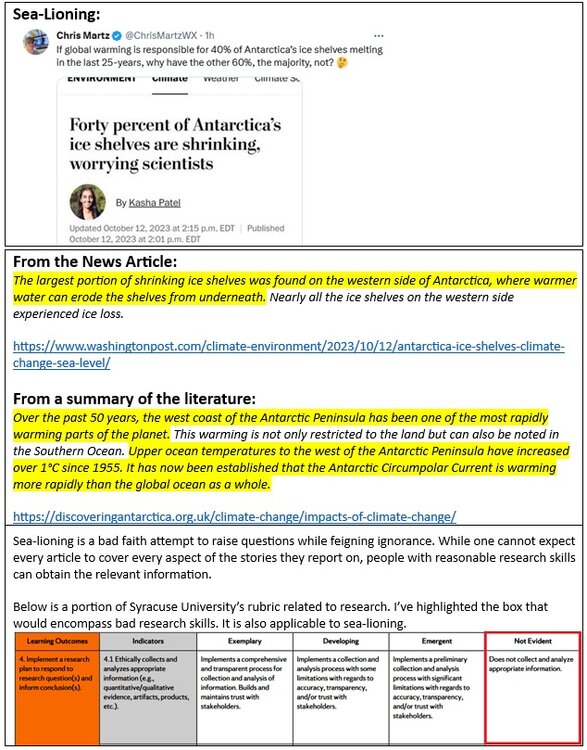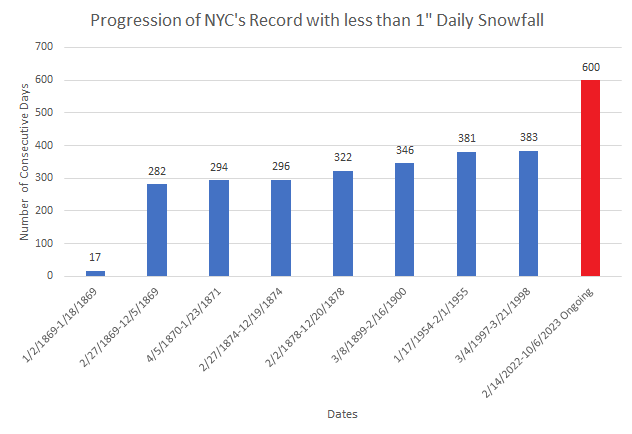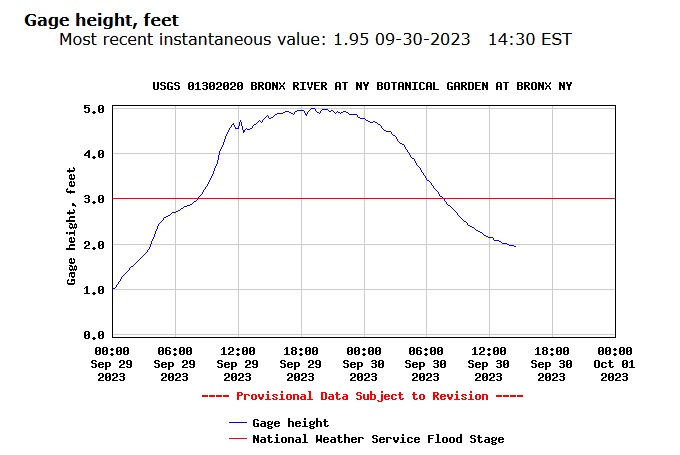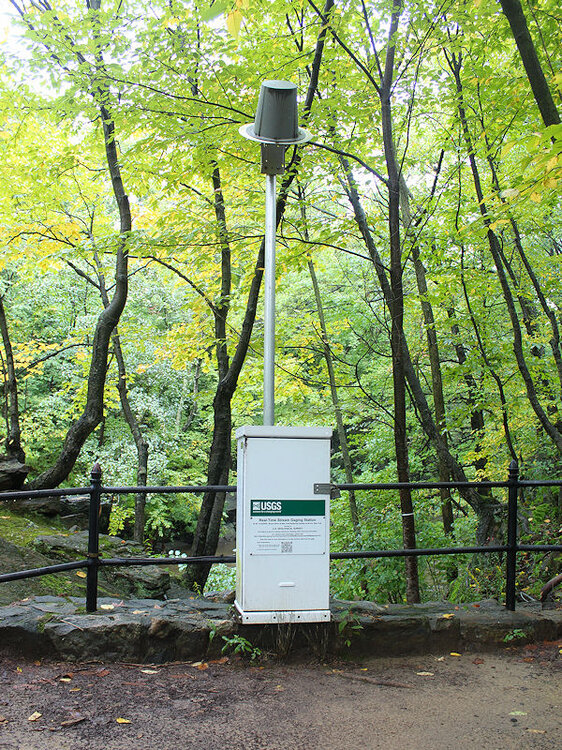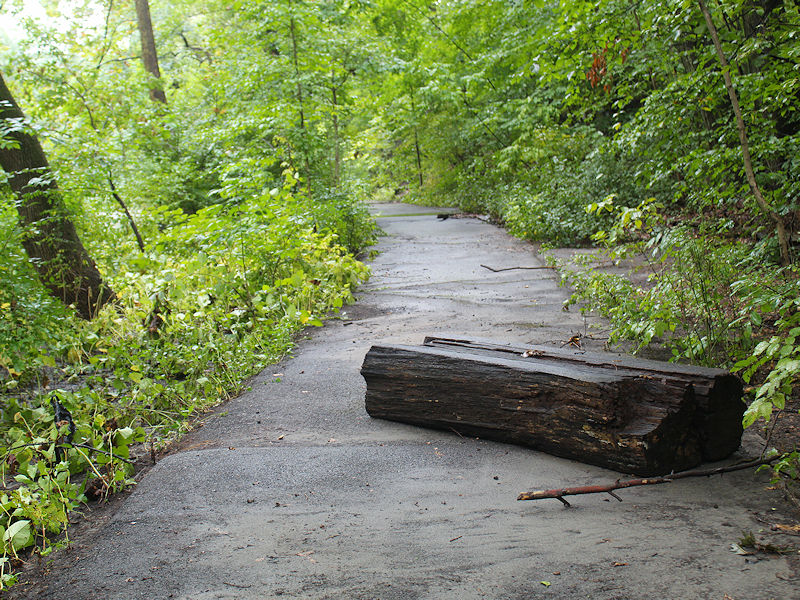-
Posts
22,981 -
Joined
Content Type
Profiles
Blogs
Forums
American Weather
Media Demo
Store
Gallery
Everything posted by donsutherland1
-
Unseasonably cool conditions will persist through at least the middle of the week. Afterward, readings could reach near normal to somewhat above normal levels. A strong cold front could bring periods of rain during the weekend. The ENSO Region 1+2 anomaly was +2.3°C and the Region 3.4 anomaly was +1.5°C for the week centered around October 11. For the past six weeks, the ENSO Region 1+2 anomaly has averaged +2.67°C and the ENSO Region 3.4 anomaly has averaged +1.57°C. El Niño conditions will likely continue to strengthen into the fall with the current East-based event transitioning to a basinwide El Niño for the upcoming winter. The SOI was not available today. The preliminary Arctic Oscillation (AO) was -1.941 today. Based on sensitivity analysis applied to the latest guidance, there is an implied 58% probability that New York City will have a warmer than normal October (1991-2020 normal). October will likely finish with a mean temperature near 58.5° (0.6° above normal). On October 12 the MJO was in Phase 8 at an amplitude of 0.295 (RMM). The October 11-adjusted amplitude was 0.298 (RMM).
-

Occasional Thoughts on Climate Change
donsutherland1 replied to donsutherland1's topic in Climate Change
I doubt that NYC will have a frost-free winter through the current century absent some anomalous event that amplifies climate change. There will likely be more winters where the coldest temperature stays in the 20s. I also think that by the mid-2030s, the 30-year average snowfall at Central Park will fall toward or perhaps below 20" based on the rising temperatures and warming oceans. Until recently, New York City's decadal mean winter temperatures had been running below the RCP 4.5 projections. The decadal extremes (coldest and warmest winters for the 10-year period in question) fell within the modeled projections. Recently, the decadal winter averages have been running somewhat warmer than the RCP 4.5 projections. All in all, the climate model projections have been reasonably skillful. -
Unseasonably cool conditions will persist through at least the middle of the week. Afterward, readings could reach near normal to somewhat above normal levels. A strong cold front could bring showers and a period of rain during the weekend. The ENSO Region 1+2 anomaly was +2.8°C and the Region 3.4 anomaly was +1.5°C for the week centered around September 27. For the past six weeks, the ENSO Region 1+2 anomaly has averaged +2.90°C and the ENSO Region 3.4 anomaly has averaged +1.58°C. El Niño conditions will likely continue to strengthen into the fall with the current East-based event transitioning to a basinwide El Niño for the upcoming winter. The SOI was -11.73 today. The preliminary Arctic Oscillation (AO) was -1.865 today. Based on sensitivity analysis applied to the latest guidance, there is an implied 55% probability that New York City will have a warmer than normal October (1991-2020 normal). October will likely finish with a mean temperature near 58.5° (0.6° above normal).
-
Much of the region excepting northern areas remains on track to receive 0.50"-1.50" of rain. The steady rain will continue into the night before tapering off to showers. Tomorrow will likely see some additional showers before clouds break. A gusty chilly wind will prevail throughout the day as another round of unseasonably cool air overspreads the region. The unseasonably cool conditions will likely persist through at least the middle of the week. Afterward, readings could reach near normal to somewhat above normal levels. The ENSO Region 1+2 anomaly was +2.8°C and the Region 3.4 anomaly was +1.5°C for the week centered around September 27. For the past six weeks, the ENSO Region 1+2 anomaly has averaged +2.90°C and the ENSO Region 3.4 anomaly has averaged +1.58°C. El Niño conditions will likely continue to strengthen into the fall with the current East-based event transitioning to a basinwide El Niño for the upcoming winter. The SOI was -4.90 today. The preliminary Arctic Oscillation (AO) was -1.653 today. Based on sensitivity analysis applied to the latest guidance, there is an implied 63% probability that New York City will have a warmer than normal October (1991-2020 normal). October will likely finish with a mean temperature near 58.7° (0.8° above normal).
-

Occasional Thoughts on Climate Change
donsutherland1 replied to donsutherland1's topic in Climate Change
Between 1961-1990 and 1991-2020, Miami has had an increase of 40 90-degree or above days. This year has seen a record number of 90 or above through 95 or above days. Climate change is leading to warming air temperatures and more frequent marine heatwaves, both of which impact Miami. -
A moderate to locally significant rain and wind storm is likely tomorrow into Sunday. A general 0.50"-1.50" rainfall appears likely across much of the area. Northern parts of the region could see much lower amounts. The storm will be followed by another round of unseasonably cool air. Unseasonably cool conditions will likely persist through at least the middle of next week. The ENSO Region 1+2 anomaly was +2.8°C and the Region 3.4 anomaly was +1.5°C for the week centered around September 27. For the past six weeks, the ENSO Region 1+2 anomaly has averaged +2.90°C and the ENSO Region 3.4 anomaly has averaged +1.58°C. El Niño conditions will likely continue to strengthen into the fall with the current East-based event transitioning to a basinwide El Niño for the upcoming winter. The SOI was -4.77 today. The preliminary Arctic Oscillation (AO) was -1.514 today. Based on sensitivity analysis applied to the latest guidance, there is an implied 61% probability that New York City will have a warmer than normal October (1991-2020 normal). October will likely finish with a mean temperature near 58.5° (0.6° above normal).
-

Occasional Thoughts on Climate Change
donsutherland1 replied to donsutherland1's topic in Climate Change
With global temperatures continuing to set records and the impacts of climate change becoming more prominent, there has been increased news coverage. Climate change deniers are trying to attack the stories, often through asking innocent-looking but dishonest and bad faith questions. Below is one example where, even if one had only minimal research skills, one could quickly find the answer to the question that was raised. -
It will turn somewhat cooler tomorrow as clouds increase ahead of the next storm. A moderate to locally significant rain and wind storm is likely Saturday into Sunday. A general 0.50"-1.50" rainfall appears likely across much of the area. Northern parts of the region could see much lower amounts. The storm will be followed by another round of unseasonably cool air. Unseasonably cool conditions will likely persist through at least the middle of next week. The ENSO Region 1+2 anomaly was +2.8°C and the Region 3.4 anomaly was +1.5°C for the week centered around September 27. For the past six weeks, the ENSO Region 1+2 anomaly has averaged +2.90°C and the ENSO Region 3.4 anomaly has averaged +1.58°C. El Niño conditions will likely continue to strengthen into the fall with the current East-based event transitioning to a basinwide El Niño for the upcoming winter. The SOI was -0.58 today. The preliminary Arctic Oscillation (AO) was -0.651 today. Based on sensitivity analysis applied to the latest guidance, there is an implied 58% probability that New York City will have a warmer than normal October (1991-2020 normal). October will likely finish with a mean temperature near 58.4° (0.5° above normal).
-
Readings will again generally reach the upper 60s across the region with warmer spots reaching or exceeding 70°. A moderate or significant rain and wind storm is likely next weekend. The storm will likely be followed by another round of unseasonably cool air. The ENSO Region 1+2 anomaly was +2.8°C and the Region 3.4 anomaly was +1.5°C for the week centered around September 27. For the past six weeks, the ENSO Region 1+2 anomaly has averaged +2.90°C and the ENSO Region 3.4 anomaly has averaged +1.58°C. El Niño conditions will likely continue to strengthen into the fall with the current East-based event transitioning to a basinwide El Niño for the upcoming winter. The SOI was -2.77 today. The preliminary Arctic Oscillation (AO) was -0.015 today. Based on sensitivity analysis applied to the latest guidance, there is an implied 55% probability that New York City will have a warmer than normal October (1991-2020 normal). October will likely finish with a mean temperature near 58.3° (0.4° above normal).
-
Coastal flooding (probably moderate) is a real possibility. We'll have to see how much rain falls and at what rate. Right now, it's looking like a 1"-2" event, which could lead to some flooding, but nowhere near the widespread flooding seen on September 29th.
-
Temperatures rose into the lower and middle 60s across the region today. The warming trend will continue tomorrow. Readings will generally reach the upper 60s across the region with warmer spots reaching or exceeding 70°. Looking farther ahead, the probability of a moderate or significant rain and wind storm next weekend has increased. The storm will likely be followed by another round of unseasonably cool air. The ENSO Region 1+2 anomaly was +2.8°C and the Region 3.4 anomaly was +1.5°C for the week centered around September 27. For the past six weeks, the ENSO Region 1+2 anomaly has averaged +2.90°C and the ENSO Region 3.4 anomaly has averaged +1.58°C. El Niño conditions will likely continue to strengthen into the fall with the current East-based event transitioning to a basinwide El Niño for the upcoming winter. The SOI was -5.87 today. The preliminary Arctic Oscillation (AO) was -0.361 today. Based on sensitivity analysis applied to the latest guidance, there is an implied 55% probability that New York City will have a warmer than normal October (1991-2020 normal). October will likely finish with a mean temperature near 58.3° (0.4° above normal).
-
Temperatures will slowly warm starting tomorrow.Readings will generally reach the lower and middle 60s in the northern Mid-Atlantic region and middle and upper 60s across southern New Jersey southward. Looking farther ahead, the probability of a moderate or significant rain and wind storm next weekend has increased. The storm will likely be followed by another round of unseasonably cool air. The ENSO Region 1+2 anomaly was +2.8°C and the Region 3.4 anomaly was +1.5°C for the week centered around September 27. For the past six weeks, the ENSO Region 1+2 anomaly has averaged +2.90°C and the ENSO Region 3.4 anomaly has averaged +1.58°C. El Niño conditions will likely continue to strengthen into the fall with the current East-based event transitioning to a basinwide El Niño for the upcoming winter. The SOI was -5.87 today. The preliminary Arctic Oscillation (AO) was -0.688 today. Based on sensitivity analysis applied to the latest guidance, there is an implied 55% probability that New York City will have a warmer than normal October (1991-2020 normal). October will likely finish with a mean temperature near 58.4° (0.5° above normal).
-
Tomorrow will be another brisk and cool day. Temperatures will remain below 60° in parts of the region. Temperatures will slowly warm afterward. Looking farther ahead, there is the possibility of a moderate or significant rain and wind storm next weekend followed by another round of unseasonably cool air. The ENSO Region 1+2 anomaly was +2.8°C and the Region 3.4 anomaly was +1.5°C for the week centered around September 27. For the past six weeks, the ENSO Region 1+2 anomaly has averaged +2.90°C and the ENSO Region 3.4 anomaly has averaged +1.58°C. El Niño conditions will likely continue to strengthen into the fall with the current East-based event transitioning to a basinwide El Niño for the upcoming winter. The SOI was -6.45 today. The preliminary Arctic Oscillation (AO) was -0.714 today. Based on sensitivity analysis applied to the latest guidance, there is an implied 56% probability that New York City will have a warmer than normal October (1991-2020 normal). October will likely finish with a mean temperature near 58.5° (0.6° above normal).
-
Following this evening's frontal passage, the coolest air mass so far this season will overspread the region. Tomorrow and Monday will be brisk and cool days. Temperatures will remain below 60° in parts of the region even as sunshine prevails. Temperatures will slowly warm afterward. The ENSO Region 1+2 anomaly was +2.8°C and the Region 3.4 anomaly was +1.5°C for the week centered around September 27. For the past six weeks, the ENSO Region 1+2 anomaly has averaged +2.90°C and the ENSO Region 3.4 anomaly has averaged +1.58°C. El Niño conditions will likely continue to strengthen into the fall with the current East-based event transitioning to a basinwide El Niño for the upcoming winter. The SOI was -5.16 today. The preliminary Arctic Oscillation (AO) was -0.511 today. Based on sensitivity analysis applied to the latest guidance, there is an implied 58% probability that New York City will have a warmer than normal October (1991-2020 normal). October will likely finish with a mean temperature near 58.7° (0.8° above normal).
-
Tomorrow will be rainy and still mild. A general 0.50"-1.50" rainfall with locally higher amounts is likely. The New York City area and nearby suburbs will likely see 1.00"-3.00" of rain. Locally higher amounts in this area could approach or reach 5.00". Following the frontal passage, the coolest air mass so far this season will overspread the region. Monday and Tuesday could see temperatures remain below 60° in parts of the region even as sunshine prevails. Temperatures will slowly warm afterward. The ENSO Region 1+2 anomaly was +2.8°C and the Region 3.4 anomaly was +1.5°C for the week centered around September 27. For the past six weeks, the ENSO Region 1+2 anomaly has averaged +2.90°C and the ENSO Region 3.4 anomaly has averaged +1.58°C. El Niño conditions will likely continue to strengthen into the fall with the current East-based event transitioning to a basinwide El Niño for the upcoming winter. The SOI was -19.21 today. The preliminary Arctic Oscillation (AO) was -0.897 today.
-
Yes. Unfortunately, that's always a risk there. It would not be the first time.
-
As hopes gradually turn to the coming winter, today will mark New York City's 600th consecutive day on which the City has not seen daily snowfall of 1" or more. No other stretch comes close.
-
Warmer than normal weather will continue for much of the first week of October. Temperatures could reach or exceed 80° tomorrow. The warmth will extend well north into Canada where Montreal and Quebec City could challenge or break their October records. Colder air will push into the East during the upcoming weekend. The cold air will be preceded by showers or periods of rain from a storm. The possibility exists for a moderate or significant rainfall. The ENSO Region 1+2 anomaly was +2.8°C and the Region 3.4 anomaly was +1.5°C for the week centered around September 27. For the past six weeks, the ENSO Region 1+2 anomaly has averaged +2.90°C and the ENSO Region 3.4 anomaly has averaged +1.58°C. El Niño conditions will likely continue to strengthen into the fall with the current East-based event transitioning to a basinwide El Niño for the upcoming winter. The SOI was -0.65 today. The preliminary Arctic Oscillation (AO) was +1.046 today.
-
Warmer than normal weather will continue for much of the first week of October. Temperatures could reach 80° or above tomorrow and Wednesday. The warmth will extend well north into Canada where Montreal and Quebec City could challenge or break their October records. Earlier today, Thunder Bay reached an October record high of 86°. Colder air will push into the East during the upcoming weekend. The cold air will be preceded by showers or periods of rain from a storm. The possibility exists for a moderate or significant rainfall. The ENSO Region 1+2 anomaly was +2.8°C and the Region 3.4 anomaly was +1.5°C for the week centered around September 27. For the past six weeks, the ENSO Region 1+2 anomaly has averaged +2.90°C and the ENSO Region 3.4 anomaly has averaged +1.58°C. El Niño conditions will likely continue to strengthen into the fall with the current East-based event transitioning to a basinwide El Niño for the upcoming winter. The SOI was -3.48 today. The preliminary Arctic Oscillation (AO) was +0.877 today.
-
Boosted by a flood of sunshine, temperatures ranged from the middle 70s to even lower 80s across the region. In the Plains States and Great Lakes Region much more intense heat prevailed. October monthly records included: Eau Claire, WI: 89° Marshall, MN: 94° Minneapolis: 92° Saint Cloud, MN: 91° Sioux Falls, SD: 95° Spencer, IA: 95° Across parts of France, Spain, and Italy hundreds of monthly records were beaten, some by 10°. Spain also saw a 101° (38.2°C) temperature, which set a new national October record. Warmer than normal weather will continue for much of the first week of October. Temperatures could reach 80° or above on several days next week. Colder air could push into the East during the upcoming weekend. The cold air will be preceded by showers or periods of rain. The ENSO Region 1+2 anomaly was +2.8°C and the Region 3.4 anomaly was +1.7°C for the week centered around September 20. For the past six weeks, the ENSO Region 1+2 anomaly has averaged +2.98°C and the ENSO Region 3.4 anomaly has averaged +1.55°C. El Niño conditions will likely continue to strengthen into the fall with the current East-based event transitioning to a basinwide El Niño for the upcoming winter. The SOI was -5.03 today. The preliminary Arctic Oscillation (AO) was +0.354 today.
-

October 2023 temperature forecast contest
donsutherland1 replied to Roger Smith's topic in Weather Forecasting and Discussion
DCA _ NYC _ BOS __ ORD _ ATL _ IAH ___ DEN _ PHX _ SEA 1.1 1.2 1.6 2.9 0.9 1.5 2.7 1.7 1.9 -
September is concluding with a mean temperature of 69.4° in New York City. That is 0.2° above normal. A spell of warmer than normal weather lies ahead for much of the first week of October. Temperatures could reach 80° or above on several days next week. However, this warmth will be minor compared to the record-breaking heat that will start October in parts of the Plains States and Midwest. Today, Macomb, IL reached 98°. The previous latest-season 90° reading occurred on September 4, 1906. Moreover, that tied the September monthly record. There remain indications that colder air could push into the East near the start of the second week of October or just afterward, possibly preceded by yet another storm. The ENSO Region 1+2 anomaly was +2.8°C and the Region 3.4 anomaly was +1.7°C for the week centered around September 20. For the past six weeks, the ENSO Region 1+2 anomaly has averaged +2.98°C and the ENSO Region 3.4 anomaly has averaged +1.55°C. El Niño conditions will likely continue to strengthen into the fall with the current East-based event transitioning to a basinwide El Niño for the upcoming winter. The SOI was -7.19 today. The preliminary Arctic Oscillation (AO) was +0.219 today.
-
- 886 replies
-
- 4
-

-
- heavy rain
- flooding potential
-
(and 2 more)
Tagged with:
-
The Bronx River crested at 4.99 feet at the New York Botanical Garden. That was about 6" below the crest achieved from the remnants of Hurricane Ida in September 2021. The River remained at flood stage for about 12 hours.
- 886 replies
-
- 5
-

-
- heavy rain
- flooding potential
-
(and 2 more)
Tagged with:
-
A major to historic rainstorm is winding down. Excessive rainfall amounts include: Hartford: 3.74" (new daily record for September 29) New York City-Central Park: 5.58" (8th highest daily figure) New York City-JFK Airport: 8.05" (new all-time daily record) ***storm total: 8.67" (new 2-day record)*** New York City-LaGuardia Airport: 4.10" Tomorrow will be drier and the clouds could break. Afterward, a spell of warmer than normal weather lies ahead for much of the first week of October. There remain indications that colder air could push into the region afterward, possibly preceded by yet another storm. The ENSO Region 1+2 anomaly was +2.8°C and the Region 3.4 anomaly was +1.7°C for the week centered around September 20. For the past six weeks, the ENSO Region 1+2 anomaly has averaged +2.98°C and the ENSO Region 3.4 anomaly has averaged +1.55°C. El Niño conditions will likely continue to strengthen into the fall with the current East-based event transitioning to a basinwide El Niño for the upcoming winter. The SOI was -7.19 today. The preliminary Arctic Oscillation (AO) was +0.219 today. Based on sensitivity analysis applied to the latest guidance, there is an implied 82% probability that New York City will have a warmer than normal September (1991-2020 normal). September will likely finish with a mean temperature near 69.4° (0.2° above normal).






